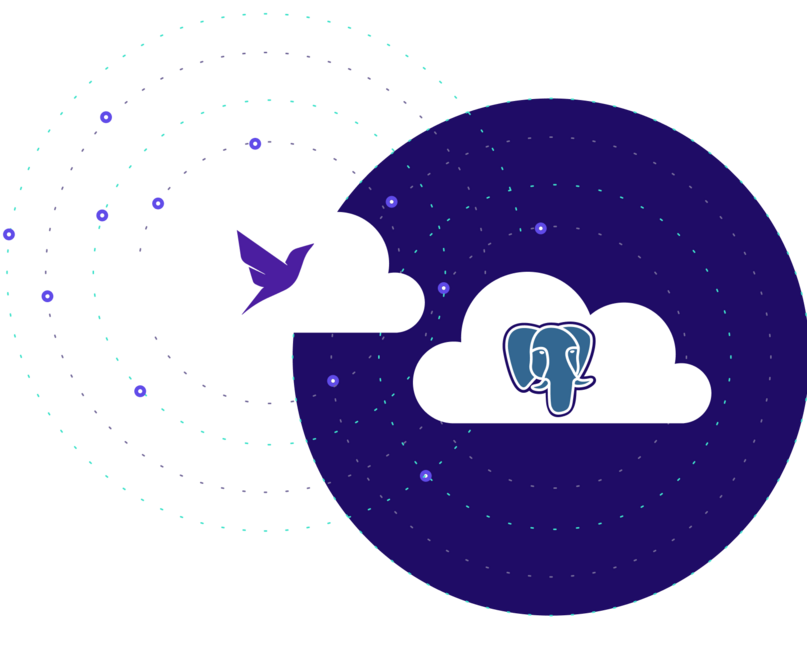







Key Differentiators
Why application teams choose Fauna over PostgreSQL

Infrastructure & Scaling Simplicity
Fauna is truly serverless and delivered as a fully managed, globally distributed service with no infrastructure to provision, configure, or scale.
PostgreSQL requires manual scaling and operational overhead—servers, replicas, sharding strategies, connection pooling—placing a heavy burden on DevOps and DBA teams.

Serverless & API-driven Connectivity
Fauna’s native HTTPS API model ensures effortless integration with serverless and edge computing environments—no middleware, drivers, or connection pools required.
PostgreSQL uses a stateful, TCP-based connection model and connection pooling, which can be complex in highly dynamic, serverless architectures.

Data Modeling Flexibility
Fauna blends document flexibility with the relational power of joins, ACID transactions, and constraints. As application requirements shift, developers can evolve schemas online without downtime or re-architecture.
PostgreSQL is a traditional relational database that relies on fixed schemas and often requires schema migrations and joins that are more rigidly structured. JSONB extension precludes indexing elements, joins, and requires parsing entire strings, which can be slow and resource-intensive.

Advanced Security & Access Control
Fauna’s architecture natively supports multi-tenancy, allowing you to define logical databases with zero overhead. Native, dynamic attribute-based access control (ABAC) unlocks security designed with modern access patterns in mind.
Multi-tenancy in PostgreSQL is possible but requires significant engineering and orchestration of multiple components. PostgreSQL offers role-based access control (RBAC) and extensions for advanced security, but can only approximate ABAC-like behavior by combining RLS policies with logic that references attributes stored in tables or user attributes managed externally.
“The serverless aspect of Fauna has allowed us to forget about the database and just focus on our business logic. Over the course of a weekend, I was able to rewrite our backend with Fauna and stand up an MVP that I could show to the rest of the executive team. Latency decreased by more than 70% compared to our PostgreSQL and Cockroach instances.”

Steve Lam
CTO @ Insights.gg

Administration & Deployment
MongoDB Atlas
Traditional node-based architecture. Single compute layer. Nuanced CPU to memory sizing. Relies on local storage or memory caching for IO performance.

MongoDB Atlas
Serverless. No ops. All features natively available, over multi-region, with consistency. Scale-ready & configuration-free serverless.
Traditional node-based architecture. Single compute layer. Nuanced CPU to memory sizing. Relies on local storage or memory caching for IO performance.
MongoDB Atlas
Administration & Deployment

Fauna vs PostgreSQL

Data Model
PostgreSQL
Rigid. Schema alterations and migrations require planning and maintenance, with rigidity that can hinder evolving application requirements. JSONB extension requires parsing entire strings, which can be slow and resource-intensive.

Flexible. Schema-less by default, Fauna allows schema enforcement with conditions and functions, providing native JSON flexibility along with relational features like dynamic joins for seamless application changes.
MongoDB Atlas
Administration & Deployment

Multi-Tenancy
PostgreSQL
Manual orchestration. Multi-tenancy in PostgreSQL often requires implementing tenancy keys and isolated tables, and isolation relies on the specific service provider’s infrastructure.

Native. Fauna’s secure, dynamically isolated multi-tenancy is built-in, making it easy to offer customer-specific data separation or organizational access controls.
MongoDB Atlas
Administration & Deployment

Hosting
PostgreSQL
Self-managed, node-based infrastructure.

True serverless. No consideration for what, where, or how the service is running.
MongoDB Atlas
Administration & Deployment

Maintenance
PostgreSQL
Intensive. PostgreSQL requires ongoing index and table maintenance. Self-managed PostgreSQL installations, and even managed cloud versions, vary by provider & require regular updates, compatibility checks, and configuration.

Abstracted. No maintenance tasks are needed for Fauna—automatic index and data management streamline operations for developers.
MongoDB Atlas
Administration & Deployment

Middleware
PostgreSQL
ORM dependent. PostgreSQL often relies on ORMs to overcome the object-relational impedance mismatch, which can add complexity and produce inefficient queries.

Code naturally maps to application objects. Fauna eliminates the need for ORMs and supports transactions, joins, relations, indexes, views, and event streams in the context of JSON.
MongoDB Atlas
Administration & Deployment

Query Predictability
PostgreSQL
Unpredictable. Query optimization can vary with each PostgreSQL version update, sometimes resulting in unpredictable performance shifts and opaque query plans.

Predictable. With composable, transparent indexes similar to materialized views, Fauna ensures consistent and predictable query plans with explicit indexing.
MongoDB Atlas
Administration & Deployment

Security
PostgreSQL
Complex. PostgreSQL has a complex security model prone to configuration errors, which can expose vulnerabilities such as SQL injection.

Dynamic. Fauna provides a robust, web-native security model with seamless integration to cloud identity providers and secure-by-default access controls.
MongoDB Atlas
Administration & Deployment

Connectivity
PostgreSQL
Session-pooling. Stateful sessions requiring sized pools.

HTTPS API. Stateless & sessionless for secure & scalable connectivity.
MongoDB Atlas
Administration & Deployment

Connection Management
PostgreSQL
Legacy. Connections in PostgreSQL require tools like PgBouncer for connection pooling, adding complexity in serverless or microservice environments.

Modern. Stateless HTTPS connections with Fauna eliminate cold start latency and connection pooling, providing truly serverless scalability without management overhead.
MongoDB Atlas
Administration & Deployment

Elastic Scalability
PostgreSQL
Resource intensive. Scaling in PostgreSQL is typically constrained by monolithic provisioning and requires capacity planning, ongoing server management, and balancing costs and performance manually.

Automatic. Fauna offers API-based elasticity, scaling horizontally and vertically without provisioning or configuration.
MongoDB Atlas
Administration & Deployment

Replication
PostgreSQL
Configured. Replication across regions requires complex configuration, with manual fault-tolerance and latency optimization in PostgreSQL.

Automatic. Leveraging the Calvin protocol, Fauna provides global data distribution, partitioning, and replication for optimal latency and fault tolerance, suited for edge applications.
MongoDB Atlas
Administration & Deployment

Data Consistency
PostgreSQL
Single region ACID. PostgreSQL’s default read-committed isolation may cause errors under high load, and ACID guarantees apply only within the primary node, not across distributed clusters.

Distributed strong consistency. Fauna enforces strict serializability for every query across distributed environments, delivering the highest isolation level globally.
MongoDB Atlas
Administration & Deployment
PostgreSQL




Data Model
Rigid. Schema alterations and migrations require planning and maintenance, with rigidity that can hinder evolving application requirements. JSONB extension requires parsing entire strings, which can be slow and resource-intensive.
Flexible. Schema-less by default, Fauna allows schema enforcement with conditions and functions, providing native JSON flexibility along with relational features like dynamic joins for seamless application changes.

Multi-Tenancy
Manual orchestration. Multi-tenancy in PostgreSQL often requires implementing tenancy keys and isolated tables, and isolation relies on the specific service provider’s infrastructure.
Native. Fauna’s secure, dynamically isolated multi-tenancy is built-in, making it easy to offer customer-specific data separation or organizational access controls.

Hosting
Self-managed, node-based infrastructure.
True serverless. No consideration for what, where, or how the service is running.

Maintenance
Intensive. PostgreSQL requires ongoing index and table maintenance. Self-managed PostgreSQL installations, and even managed cloud versions, vary by provider & require regular updates, compatibility checks, and configuration.
Abstracted. No maintenance tasks are needed for Fauna—automatic index and data management streamline operations for developers.

Middleware
ORM dependent. PostgreSQL often relies on ORMs to overcome the object-relational impedance mismatch, which can add complexity and produce inefficient queries.
Code naturally maps to application objects. Fauna eliminates the need for ORMs and supports transactions, joins, relations, indexes, views, and event streams in the context of JSON.

Query Predictability
Unpredictable. Query optimization can vary with each PostgreSQL version update, sometimes resulting in unpredictable performance shifts and opaque query plans.
Predictable. With composable, transparent indexes similar to materialized views, Fauna ensures consistent and predictable query plans with explicit indexing.

Security
Complex. PostgreSQL has a complex security model prone to configuration errors, which can expose vulnerabilities such as SQL injection.
Dynamic. Fauna provides a robust, web-native security model with seamless integration to cloud identity providers and secure-by-default access controls.

Connectivity
Session-pooling. Stateful sessions requiring sized pools.
HTTPS API. Stateless & sessionless for secure & scalable connectivity.

Connection Management
Legacy. Connections in PostgreSQL require tools like PgBouncer for connection pooling, adding complexity in serverless or microservice environments.
Modern. Stateless HTTPS connections with Fauna eliminate cold start latency and connection pooling, providing truly serverless scalability without management overhead.

Elastic Scalability
Resource intensive. Scaling in PostgreSQL is typically constrained by monolithic provisioning and requires capacity planning, ongoing server management, and balancing costs and performance manually.
Automatic. Fauna offers API-based elasticity, scaling horizontally and vertically without provisioning or configuration.

Replication
Configured. Replication across regions requires complex configuration, with manual fault-tolerance and latency optimization in PostgreSQL.
Automatic. Leveraging the Calvin protocol, Fauna provides global data distribution, partitioning, and replication for optimal latency and fault tolerance, suited for edge applications.

Data Consistency
Single region ACID. PostgreSQL’s default read-committed isolation may cause errors under high load, and ACID guarantees apply only within the primary node, not across distributed clusters.
Distributed strong consistency. Fauna enforces strict serializability for every query across distributed environments, delivering the highest isolation level globally.
Use Cases Where Fauna Out-Performs PostgreSQL
Fauna excels in environments where modern application requirements demand flexibility, scalability, and cost optimization, especially for dynamic, distributed workloads.
Applications Demanding Multi-Region Performance & Reliability
Fauna’s multi-region, multi-active architecture handles writes and reads globally, delivering low-latency access with strict consistency—no manual replication or failover planning.
PostgreSQL relies on single-region primary instances with replicas for reads. Achieving global distribution requires complex replication tooling and potentially multiple services stitched together.


Applications Requiring Flexible Schemas
Fauna uniquely combines the flexibility of a document store with the relational sophistication of joins, constraints, and enforced schemas. As application requirements evolve, developers can effortlessly adapt their data model, add or adjust relations, and introduce new data constraints—all without downtime, re-architecture, or complex migrations.
PostgreSQL’s relational core is powerful but rigid—changes often involve schema migrations, downtime windows, or non-trivial DevOps cycles.
Serverless and Edge Architectures
Fauna’s stateless, API-based access model integrates seamlessly into serverless functions and edge deployments.
PostgreSQL connections demand long-lived sessions and reliance on connection pools, which complicates scaling and introduces additional latency and operational overhead in ephemeral compute environments.


Multi-tenant SaaS Platforms
Fauna’s resource model naturally supports logical databases for each tenant, combined with fine-grained, dynamic access controls.
PostgreSQL can be multi-tenant but usually requires isolated clusters, heavy provisioning, and custom solutions or middleware to isolate data and enforce security at scale.
Fauna vs PostgreSQL Derivatives
Below are brief comparisons to popular Postgres-based or Postgres-compatible derivatives, each addressing some PostgreSQL challenges but still falling short of Fauna’s serverless, globally consistent, and flexible model.
Fauna vs CockroachDB
CockroachDB aims to bring global distribution and horizontal scaling to a Postgres-compatible database. While it does simplify certain scaling tasks compared to vanilla Postgres, it still often requires significant operational know-how, configuration, and tuning.

Scaling & Infrastructure
CockroachDB offers distributed SQL, but you still need to manage clusters, nodes, and versions. Fauna is zero-ops, requiring no cluster management at all.

Data Model Flexibility
CockroachDB uses a relational model with SQL compatibility. Fauna goes further by blending document flexibility with relational joins and schema constraints, offering more adaptability.

Connectivity
CockroachDB relies on traditional SQL connections. Fauna uses a serverless, API-based approach—no connection pooling, easier edge and serverless integration.

Multi-tenancy & Security
CockroachDB supports multi-region clusters but leaves tenant isolation and dynamic access policies as custom solutions. Fauna’s multi-tenant architecture and ABAC-based security are built-in.
Fauna vs Amazon Aurora
Amazon Aurora provides a managed Postgres-compatible service with improved performance and availability features. However, it retains much of PostgreSQL’s complexity and does not reach Fauna’s level of simplicity or flexibility. Visit here for a deep dive.

Management
Aurora simplifies some operations but still involves instance sizing, capacity planning, and complex scaling strategies. Fauna’s serverless model scales seamlessly without config changes.

Global Distribution
Aurora can replicate across regions, but typically requires manual setup, specialized endpoints, and handling eventual consistency. Fauna’s multi-active architecture provides global, strongly consistent access by default.

Access Patterns
Aurora maintains a connection-based model and doesn’t natively support document or embedded data. Fauna’s flexible model and API-driven connectivity streamline modern app development.

Data Model Flexibility
Aurora extends MySQL/PostgreSQL with a rigid, schema-based model and relies on traditional migrations. Even with JSON, schema changes often need downtime. Fauna blends flexible documents, strict ACID, and built-in programmability—no re-architecture required.
Fauna vs Neon
Neon is a serverless Postgres offering focused on separating storage and compute for elasticity. It removes some traditional ops overhead but remains fundamentally anchored to Postgres’ relational model and connection-based approach.

Serverless Scaling
Neon adds serverless-like autoscaling to Postgres. Fauna is natively serverless, with no configuration overhead and a globally distributed architecture.

Data Model & Schema
Neon inherits Postgres’ rigid schema structure. Fauna’s document-relational approach provides schema enforcement with more agility.

Global Reach
Neon is simpler than standard Postgres but lacks Fauna’s global, strongly consistent, multi-region presence by default.

Connectivity
Neon still uses PostgreSQL protocol connections. Fauna’s HTTPS-based API suits serverless and edge environments better.

Get started building with Fauna
Explore resources that can help get you up and running in minutes.
Multi-tenant SaaS Sample App
Learn how to build a multi-tenant, multi-region SaaS app without ops using Fauna and AWS
BUILD THE SAMPLE APP
New to Fauna Query Language?
This guide can help you get started with FQL in under 10 minutes.
READ MORE
Workshops
Learn how to build complete applications using technology like AWS, Cloudflare, and more.
EXPLORE THE WORKSHOPS
FAQs
Have other questions? Feel free to contact us, or browse our documentation.

Traditional node-based architecture. Single compute layer. Nuanced CPU to memory sizing. Relies on local storage or memory caching for IO performance.